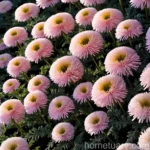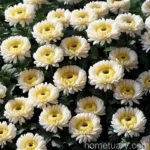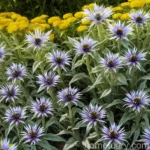The Beautiful and Versatile White Wood Aster (Eurybia divaricata ‘Eastern Star’)
Introduction
White wood aster, scientifically known as Eurybia divaricata ‘Eastern Star’, is a stunning perennial plant that belongs to the Asteraceae family. This species is native to the Eastern United States and Canada, and it has gained popularity among gardeners and landscaping enthusiasts due to its delicate appearance and adaptability. In this comprehensive guide, we will delve into the key aspects of white wood aster, including its culture, uses, care requirements, propagation, and much more.
What is White Wood Aster (Eurybia divaricata ‘Eastern Star’)?
Botanical Description
White wood aster is a herbaceous perennial that typically reaches a height of 1 to 3 feet and spreads out to form dense clusters. It features attractive, dark green, lance-shaped leaves that emit a pleasant fragrance when crushed. The plant produces an abundance of dainty, star-shaped white flowers with yellow centers, creating a striking contrast against the foliage.
Common Names
White wood aster is also referred to as ‘Eastern Star’ due to the radiant appearance of its flowers.
Natural Habitat
This species thrives in woodlands, meadows, and shady, moist areas, making it well-suited for naturalizing in woodland gardens, shady borders, and native plant landscapes.
Key Takeaways – White Wood Aster (Eurybia divaricata ‘Eastern Star’)
Culture
- Hardiness Zones: White wood aster is adapted to USDA hardiness zones 3 to 9, making it suitable for a wide range of climates.
- Soil: It thrives in well-draining, humus-rich soil with a slightly acidic to neutral pH.
- Water: Maintain moist soil conditions, especially during the establishment phase, and provide supplemental watering during dry spells.
- Sunlight: Partial shade to full shade. It prefers dappled sunlight and protection from intense midday sun.
Uses
- Landscaping: White wood aster is ideal for woodland gardens, shade gardens, naturalistic landscapes, and native plant habitats.
- Wildlife Habitat: It attracts pollinators, such as bees and butterflies, and provides shelter for small wildlife.
Maintenance
- Pruning: Minimal pruning is needed. Deadheading spent flowers can promote extended blooming.
- Fertilization: A light application of balanced, organic fertilizer in spring can support healthy growth.
- Propagation: This plant can be propagated from division or seeds, providing an opportunity to expand your garden or share with fellow gardening enthusiasts.
White Wood Aster (Eurybia divaricata ‘Eastern Star’) Care
Water
White wood aster thrives in consistently moist soil. While it can tolerate short periods of drought, especially once established, regular watering is essential for optimal growth and flowering. Water deeply and allow the soil to partially dry before the next watering session. Applying a layer of organic mulch around the plants can help retain soil moisture and reduce the frequency of watering.
Sunlight
This species prefers shaded conditions and is well-suited to areas with partial to full shade. Direct sunlight, especially intense afternoon sun, should be avoided to prevent leaf scorch and stress on the plant. In the ideal shaded environment, white wood aster will thrive and produce an abundance of delicate blooms.
Fertilizer
White wood aster generally thrives in nutrient-rich soil and does not require heavy fertilization. However, a balanced, organic fertilizer can be applied in early spring to provide a nutrient boost for lush foliage and vibrant flowers. A slow-release, granular fertilizer or a liquid organic fertilizer can be suitable options.
Soil
The ideal soil for white wood aster is well-draining, rich in organic matter, and slightly acidic to neutral. Amending the soil with compost or well-decomposed organic matter can enhance its structure and fertility, creating an optimal growing environment for the plant.
Pruning
Pruning requirements for white wood aster are minimal. However, deadheading spent blooms can prolong the flowering period and encourage the plant to redirect its energy into producing new flowers. Removing any damaged or unsightly foliage can also improve the plant’s overall appearance.
Propagation
- Division: White wood aster can be propagated through division, which involves carefully separating established clumps of the plant into smaller sections and transplanting them to new locations. This method is best performed in early spring or fall.
- Seeds: Collecting and sowing seeds is another effective way to propagate white wood aster. The seeds should be sown in a well-prepared seedbed or containers, and they typically require a period of cold stratification before germination.
Container Popularity
White wood aster can be grown in containers, particularly for gardeners with limited space or those looking to create charming displays on patios, balconies, or shaded areas. When selecting a container, ensure that it provides adequate drainage and has enough room for the plant to establish its root system.
Common Diseases
White wood aster is relatively resistant to diseases and pests, especially when grown in suitable growing conditions. However, it may be susceptible to certain fungal diseases, such as powdery mildew and leaf spot, if the foliage remains consistently wet or if air circulation is poor. Ensuring proper spacing between plants and allowing for adequate airflow can help mitigate the risk of these diseases.
Disease Diagnosis
Diagnosing diseases in white wood aster involves careful observation of the plant’s foliage and overall appearance. Look for signs of discoloration, spots, or powdery coatings on the leaves, which can indicate the presence of fungal diseases. If symptoms are detected, prompt action, such as adjusting watering practices, improving air circulation, or applying appropriate fungicidal treatments, may be necessary to control the spread of the disease.
Common Pests
While white wood aster generally experiences minimal pest issues, it may attract certain pests, such as aphids or spider mites, especially during periods of stress or when grown in less than ideal conditions. Regularly inspecting the plants for any signs of pest infestation and using targeted control methods, such as insecticidal soaps or horticultural oils, can effectively manage pest populations.
Botanist’s Tips
- Incorporate white wood aster into shade gardens, wetland edges, and naturalistic landscapes to enhance biodiversity and create visually appealing settings.
- Pair white wood aster with other shade-tolerant perennials, such as hostas, ferns, and coral bells, to create engaging and dynamic plant combinations.
- Observing and understanding the natural habitat of white wood aster in the wild can provide valuable insights into its cultural preferences and growing requirements in cultivation.
Fun Facts
- In its natural habitat, white wood aster contributes to the ecological balance by attracting pollinators and supporting native wildlife.
- The delicate flowers of white wood aster create a picturesque display when planted in mass groupings, adding a touch of elegance to shaded areas.
Links to External Resources
To explore more information about white wood aster and its cultivation, refer to the following resources:
1. The Native Plant Database – Eurybia divaricata
2. White Wood Aster Plant Profile – Missouri Botanical Garden
In conclusion, white wood aster (Eurybia divaricata ‘Eastern Star’) is a versatile perennial plant that adds beauty and ecological value to shaded landscapes. By understanding its cultural needs, maintenance requirements, and propagation methods, gardeners can successfully incorporate this charming plant into their outdoor spaces, contributing to enriching the natural environment and creating delightful garden settings.
Through comprehensive care and thoughtful placement, white wood aster can thrive, delighting with its graceful flowers and contributing to the well-being of the surrounding ecosystem. Whether enjoyed in the traditional garden setting or in a naturalized habitat, this striking plant captivates with its delicate blooms and enduring appeal.















